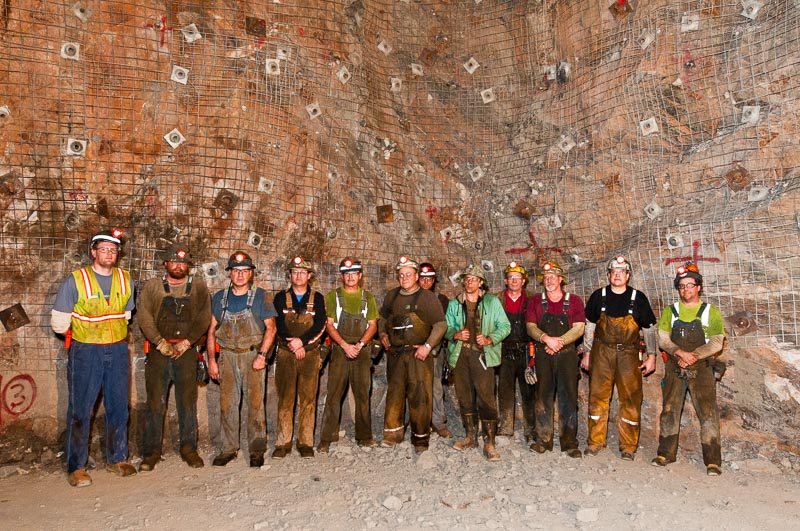
William McElroy returns to Sanford Lab as operations program manager.
William McElroy remembers a question lurking uncomfortably in his mind when he first stepped foot onto the 4850 Level of Sanford Underground Research Facility (Sanford Lab) in 2009: Is this place going to last?
"Early on, that question was in the back of everyone's mind," McElroy recalls.
At the time, the future of the underground facility was uncertain. No one had been to the deep underground levels since the facility’s closure in 2002. Selected as the location for America’s underground laboratory, the facility had to establish underground infrastructure and prove its ability to host cutting-edge research.
“When I started, my job was to set up two experiments called the Large Underground Xenon (LUX) experiment and the Majorana Demonstrator. Then, they were considered ‘early science’ pilot programs that would prove our ability to host science,” McElroy said.
On his first trip to the 4850 Level, McElroy remembers being guided by Jack Stratton, a veteran miner who had worked for Homestake Mining Company, through murky water up to his knees. They trudged through the level. The air was stagnant, and the drifts were dark. When they arrived at the Davis Cavern, McElroy was bewildered.
“I remember saying, ‘They want what? Down here?’” McElroy said. “There was no infrastructure. There was no power. And the level was all but flooded.”
McElroy led the team of 12 that expanded the Davis Cavern, then worked with contractors to establish infrastructure by building walls, installing plumbing and connecting electricity. The project would eventually create today’s Davis Campus: a laboratory with class-100 clean spaces, hosting experiments with record-setting backgrounds.

Leading the way
In 2016, McElroy became President of Ainsworth Benning Construction in Spearfish, SD. Now, he is returning to Sanford Lab as Operations Program Manager. Upon his return, he realizes just how far the facility has come.
“We no longer wonder if this place is going to last. Now, we know that this facility will lead,” McElroy said. “Sanford Lab is a leader in underground science and operations. What were considered ‘pilot science programs’ in 2009 are now recognized as world-leading scientific experiments and anchors for this facility.”
As Operations Program Manager, McElroy will focus on aligning Sanford Lab with the requirements of the South Dakota Science and Technology Authority’s Cooperative Agreement with the U.S. Department of Energy. His efforts will be devoted to increasing efficiency, coordination and management of operations activities.
“I’ve known Will for over 21 years and have worked directly with him for three quarters of that time,” said Mike Headley, executive director of Sanford Lab. “We are happy to have him back. He has a strong understanding of the facility and will readily help us move forward.”
McElroy’s career as a project management professional has enabled him to apply project management principles to a variety of projects. He was a senior project manager at Earth Resources Observation and Science (EROS) Center on the eastern side of South Dakota before moving to underground construction at Sanford Lab. In addition to the Davis Campus project, McElroy led the beginnings of the Ross Rehabilitation project. He served as the President of Ainsworth Benning Construction from 2016 to 2019.
Born and raised in South Dakota, McElroy is pleased to be able to have a career in sciences in this state. “I feel tremendously blessed to live in South Dakota and be involved with aerospace on the Eastern side and underground science on the West side,” McElroy said.
Marked by growth
“I have a new perspective and appreciation of this facility after coming back,” McElroy said. “This place would not be here if it wasn't for the tenacity, desire and caliber of the people at Sanford Lab.”
Currently, more than 200 people are employed by SURF. To accommodate the growing experiment activity, employment at SURF has grown by 25 percent over the past two years.
New hires in 2019 include infrastructure technicians Dustin Cermak, Chance Kinghorn, Jacob Mergen, Dakota VanDerVliet, Dan Essink, Jake Canfield, Anthony Fredericksen, Jason Grenstiner, Jacob Podoll, and James Nonnast; emergency rescue team members Matthew Anderson, Jessica Santee, Barry VanSickle, Nicole Nemmers, Andrew Pisciotta, Dennis Schmidt, Paul Rossum and Jacob Walker; Brett Stenson, senior safety specialist; Pamela Jacobs, accountant; Alex Geffre, engineering technical associate; Scott Meyers, QA/QC manager; Cory Pritchard, electrical engineer; Jeffrey Barthel, engineering technical associate; Jason Connot, underground operations engineer; Erin Broberg, communications specialist; Taylor Knottnerus, security; Sarah Wortman, laboratory custodian; Tony Dargatz, environmental property custodian; Angelia Uhl, procurement specialist; Denis Flemming, QC specialist; Brandon Grodzin, security; Bradley Grismer, QC/compliance specialist; Susan Thompson, warehouse specialist; and Matthew Symonds, business services & contracts manager.